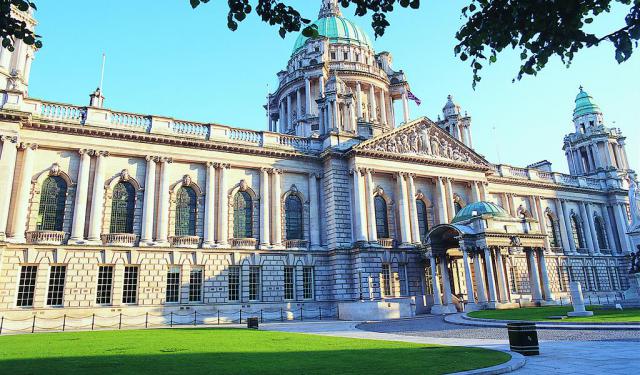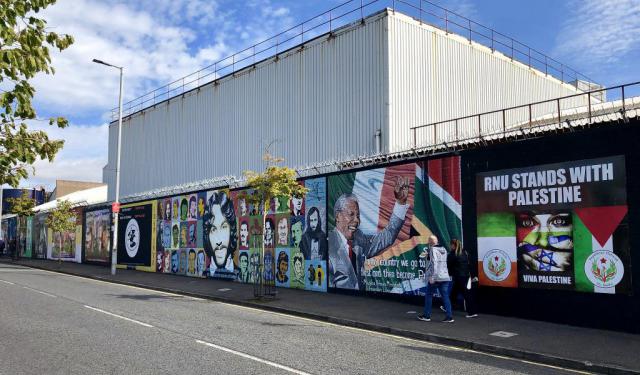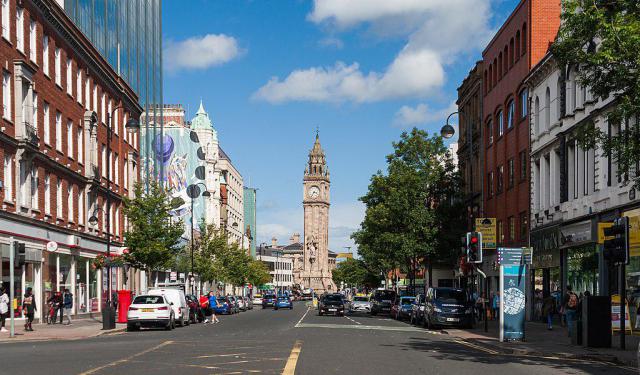
Grand Opera House, Belfast (must see)
The Grand Opera House is a historical theatre designed by the most prolific theatre architect of the period, Frank Matcham. It opened on 23 December 1895. According to The Theatres Trust the "magnificent auditorium is probably the best surviving example in the United Kingdom of the oriental style applied to theatre architecture".
It was renamed the Palace of Varieties in 1904, although it reverted to its original name in 1909. Variety programmes dominated in the 1920s and 1930s and the theatre saw performances by famous British performers such as Gracie Fields, Will Fyffe and Harry Lauder. It became a repertory theatre during World War II and at the celebrations to mark the end of the war, Eisenhower, Montgomery and Alanbrooke attended gala performances at the theatre.
The Grand Opera House was used as a cinema between 1949 and 1972, after which it was almost demolished, only to open again in 1980. The theatre was added to the list of national historical buildings in the 1970s and has been restored extensively since.
The building had been damaged by bombs on several occasions usually when the nearby Europa Hotel had been targeted. It was very badly damaged by bomb blasts in 1991 and 1993. The theatre continued to thrive, however, hosting musicals, plays, pantomimes and live music.
In 1995 the running of the theatre was taken over by the Grand Opera House Trust and an extensive renovation was undertaken in 2006. The theatre now also has a restaurant on the third floor called "The Hippodrome", on the ground floor a daytime bistro called "Luciano's" as well as space for corporate meetings and functions.
It was renamed the Palace of Varieties in 1904, although it reverted to its original name in 1909. Variety programmes dominated in the 1920s and 1930s and the theatre saw performances by famous British performers such as Gracie Fields, Will Fyffe and Harry Lauder. It became a repertory theatre during World War II and at the celebrations to mark the end of the war, Eisenhower, Montgomery and Alanbrooke attended gala performances at the theatre.
The Grand Opera House was used as a cinema between 1949 and 1972, after which it was almost demolished, only to open again in 1980. The theatre was added to the list of national historical buildings in the 1970s and has been restored extensively since.
The building had been damaged by bombs on several occasions usually when the nearby Europa Hotel had been targeted. It was very badly damaged by bomb blasts in 1991 and 1993. The theatre continued to thrive, however, hosting musicals, plays, pantomimes and live music.
In 1995 the running of the theatre was taken over by the Grand Opera House Trust and an extensive renovation was undertaken in 2006. The theatre now also has a restaurant on the third floor called "The Hippodrome", on the ground floor a daytime bistro called "Luciano's" as well as space for corporate meetings and functions.
Sight description based on Wikipedia.
Want to visit this sight? Check out these Self-Guided Walking Tours in Belfast. Alternatively, you can download the mobile app "GPSmyCity: Walks in 1K+ Cities" from Apple App Store or Google Play Store. The app turns your mobile device to a personal tour guide and it works offline, so no data plan is needed when traveling abroad.
Grand Opera House on Map
Sight Name: Grand Opera House
Sight Location: Belfast, Ireland (See walking tours in Belfast)
Sight Type: Attraction/Landmark
Guide(s) Containing This Sight:
Sight Location: Belfast, Ireland (See walking tours in Belfast)
Sight Type: Attraction/Landmark
Guide(s) Containing This Sight:
Walking Tours in Belfast, Ireland
Create Your Own Walk in Belfast
Creating your own self-guided walk in Belfast is easy and fun. Choose the city attractions that you want to see and a walk route map will be created just for you. You can even set your hotel as the start point of the walk.
Belfast Victorian Architecture Jewels
Described as “modestly scaled, undemonstrative, somewhat solid in aspect, and usually restrained (sometimes even austere) in its use of external decoration”, the urban landscape of Belfast has been influenced by the demands of shipbuilding and linen industry, much as transitioning between culture, arts, commerce, and education. Still, the architectural spectrum of the city is quite broad and... view more
Tour Duration: 2 Hour(s)
Travel Distance: 2.9 Km or 1.8 Miles
Tour Duration: 2 Hour(s)
Travel Distance: 2.9 Km or 1.8 Miles
The Troubles and Peace Process Landmarks
Decades past the official end of The Troubles in Belfast, the price of peace in Northern Ireland remains high. One of the means with which to secure it, back in 1969, was erecting a wall to physically separate the capital's warring Protestant and Catholic communities. Known since as the Peace Wall, the structure has become a popular tourist attraction for the multiple murals painted thereon... view more
Tour Duration: 1 Hour(s)
Travel Distance: 2.1 Km or 1.3 Miles
Tour Duration: 1 Hour(s)
Travel Distance: 2.1 Km or 1.3 Miles
Belfast Introduction Walking Tour
For over a century, the political situation of Belfast, the capital of Northern Ireland, has been the source of strife, first between the Crown-loyal Protestants and Irish Catholics, and more recently between the United Kingdom and the European Union.
Sitting on the banks of the River Lagan where it meets the Irish Sea, the city owes its name to this coastal condition, with "Belfast"... view more
Tour Duration: 2 Hour(s)
Travel Distance: 3.5 Km or 2.2 Miles
Sitting on the banks of the River Lagan where it meets the Irish Sea, the city owes its name to this coastal condition, with "Belfast"... view more
Tour Duration: 2 Hour(s)
Travel Distance: 3.5 Km or 2.2 Miles



